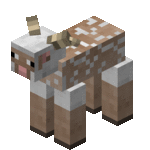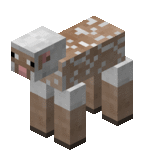Sheep
| This page contains content about features that are outdated, or have possibly been removed from the game. These features only exist in older, outdated versions of TFC. This information is to be used at your own risk, as it is possible that is no longer correct in the current latest version of TFC: 0.79.29.922. It is also possible that this page is missing information regarding new mechanics in the current version. For a brief summary of accurate, up-to-date information, please check the Changelog.
|
| Health Points |
400 |
| Spawn |
Mountains, but not too hot or too dry |
| Can Despawn |
No |
| Drops |
|
| Offspring |
1-4 |
Contents
Appearance
Adult Male Sheep are distinguishable from their female counterparts by their horns.
Most sheep upon natural generation have white wool. Others can naturally spawn in black, gray, light gray, brown or pink wool. They have light tan skin and are wall-eyed and have a pink square for his mouth. When sheared the sheep's wool will be gone and will be seen in spots upon the sheep's back in a mottled pattern. However, this will stay white no matter what color the sheep's wool is and you can see its pink, tanned skin. Also, when sheared, ears on the head are exposed and can be seen.
The color of sheep in TFC is purely aesthetic, and has no affect on the wool obtained from the sheep.
The majority of sheep are white, with a 81.836% chance of spawning. The light grey, dark grey, and black sheep have an in-the-middle chance of spawning: 5%. Using a spawn egg to get one of these sheep types lies at a reasonable 15%.
Brown sheep have an uncommon 3% chance to spawn.
The rarest of the bunch is the Pink Sheep: a tiny 0.164% chance of getting one naturally.
Usage
Wool can only be obtained from adult sheep. Wool can be obtained from sheep by using Shears or a Knife on the sheep or killing a non-sheared sheep and processing the Sheepskin. Sheep regrow wool by eating grass and turning the grass block into a dirt block; they can also eat tall grass, destroying the block itself. Lambs eat grass much faster than adults. The sheep's head also moves down and wiggles to imitate eating, but a lamb's head goes inside the dirt itself.
Sheep can also be butchered for Mutton, which when cooked has a filling value of ✭✭✭✭✩, and is therefore comparable to Beef. The larger the sheep, the more mutton it will drop upon death.
Behavior
Sheep tend to be one of the lesser intellects in the game, and have been known to walk into lava. Like other passive land mobs, sheep wander around aimlessly. They can be heard bleating occasionally, even from some distance away. When they encounter an obstacle, they will often try to jump over it, which may cause some odd, and rather humorous, behavior at obstacles they cannot overcome. Sheep will eat grass, turning it into dirt. This will make their wool grow back. The regrown wool will be of the same color as before the sheep was sheared, regardless of the original color. Packs of wolves may attack the occasional individual loner. If you are trying to capture a sheep for breeding or shearing, it will follow you as long as you are holding wheat grain or have a lead attached to the sheep. Keep in mind this can get very overwhelming if you are near a large flock of sheep as they will all try to follow you.
Breeding
- Main article: Animal Husbandry
Sheep can be bred with all grains except rice. Since Sheep of all colors drop the same wool item, only animal size needs to be taken into account when breeding, as larger animals will have generally larger offspring.
After the lambs have spawned, they will follow their parents for 3 months before becoming adults.
| Navigation | |
|---|---|
| Construction | Barrels • Blueprints • Bricks • Firepit • Plank Blocks • Protection Meter • Quern • Smooth Stone • Straw & Hide Bed • Support Beams • Thatch |
| Environment | Altitude • The Player • Calendar • Cobblestone • Logs • Mobs • Saplings • Seasons • Stone • Temperature • Trees |
| Food | Agriculture • Animal Husbandry • Berries • Fruit Trees |
| Materials | Charcoal • Coal • Double Ingots • Double Sheets • Flux • Gems • Gunpowder • Hides • Ingots • Leather • Lumber • Minerals • Pottery • Redstone/Powders • Sheets • Sticks • Straw • Unshaped Metal • Wool |
| Metalworking | Alloys • Anvils • Armor • Bellows • Blast Furnace • Bloomery • Tool Molds • Crucible • Forge • Gold Pan • Metals • Ores • Sluice |
| Tools & Weapons | Arrows • Axe • Buckets • Chisel • Firestarter • Flint & Steel • Hammer • Hoe • Javelin • Knife • Mace • Pickaxe • Prospector's Pick • Saw • Shovel • Sword • Scythe • Shears • Spindle |
| Other | Crafting Differences • Item Index |


